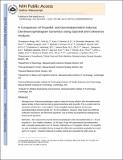A Comparison of Propofol- and Dexmedetomidine-induced Electroencephalogram Dynamics Using Spectral and Coherence Analysis
Author(s)
Akeju, Oluwaseun; Pavone, Kara J.; Westover, M. Brandon; Vazquez, Rafael; Prerau, Michael J.; Harrell, Priscilla G.; Hartnack, Katharine E.; Rhee, James; Sampson, Aaron L.; Habeeb, Kathleen; Lei, Gao; Pierce, Eric T.; Walsh, John L.; Brown, Emery N.; Purdon, Patrick Lee; ... Show more Show less
DownloadBrown_A comparison.pdf (1.707Mb)
OPEN_ACCESS_POLICY
Open Access Policy
Creative Commons Attribution-Noncommercial-Share Alike
Terms of use
Metadata
Show full item recordAbstract
Background:: Electroencephalogram patterns observed during sedation with dexmedetomidine appear similar to those observed during general anesthesia with propofol. This is evident with the occurrence of slow (0.1 to 1 Hz), delta (1 to 4 Hz), propofol-induced alpha (8 to 12 Hz), and dexmedetomidine-induced spindle (12 to 16 Hz) oscillations. However, these drugs have different molecular mechanisms and behavioral properties and are likely accompanied by distinguishing neural circuit dynamics.
Methods:: The authors measured 64-channel electroencephalogram under dexmedetomidine (n = 9) and propofol (n = 8) in healthy volunteers, 18 to 36 yr of age. The authors administered dexmedetomidine with a 1-µg/kg loading bolus over 10 min, followed by a 0.7 µg kg−1 h−1 infusion. For propofol, the authors used a computer-controlled infusion to target the effect-site concentration gradually from 0 to 5 μg/ml. Volunteers listened to auditory stimuli and responded by button press to determine unconsciousness. The authors analyzed the electroencephalogram using multitaper spectral and coherence analysis.
Results:: Dexmedetomidine was characterized by spindles with maximum power and coherence at approximately 13 Hz (mean ± SD; power, −10.8 ± 3.6 dB; coherence, 0.8 ± 0.08), whereas propofol was characterized with frontal alpha oscillations with peak frequency at approximately 11 Hz (power, 1.1 ± 4.5 dB; coherence, 0.9 ± 0.05). Notably, slow oscillation power during a general anesthetic state under propofol (power, 13.2 ± 2.4 dB) was much larger than during sedative states under both propofol (power, −2.5 ± 3.5 dB) and dexmedetomidine (power, −0.4 ± 3.1 dB).
Conclusion:: The results indicate that dexmedetomidine and propofol place patients into different brain states and suggest that propofol enables a deeper state of unconsciousness by inducing large-amplitude slow oscillations that produce prolonged states of neuronal silence.
Date issued
2014-11Department
Institute for Medical Engineering and Science; Harvard University--MIT Division of Health Sciences and Technology; Massachusetts Institute of Technology. Department of Brain and Cognitive Sciences; Picower Institute for Learning and MemoryJournal
Anesthesiology
Publisher
Ovid Technologies (Wolters Kluwer) - Lippincott Williams & Wilkins
Citation
Akeju, Oluwaseun, Kara J. Pavone, M. Brandon Westover, Rafael Vazquez, Michael J. Prerau, Priscilla G. Harrell, Katharine E. Hartnack, et al. “A Comparison of Propofol- and Dexmedetomidine-Induced Electroencephalogram Dynamics Using Spectral and Coherence Analysis.” Anesthesiology 121, no. 5 (November 2014): 978–989.
Version: Author's final manuscript
ISSN
0003-3022